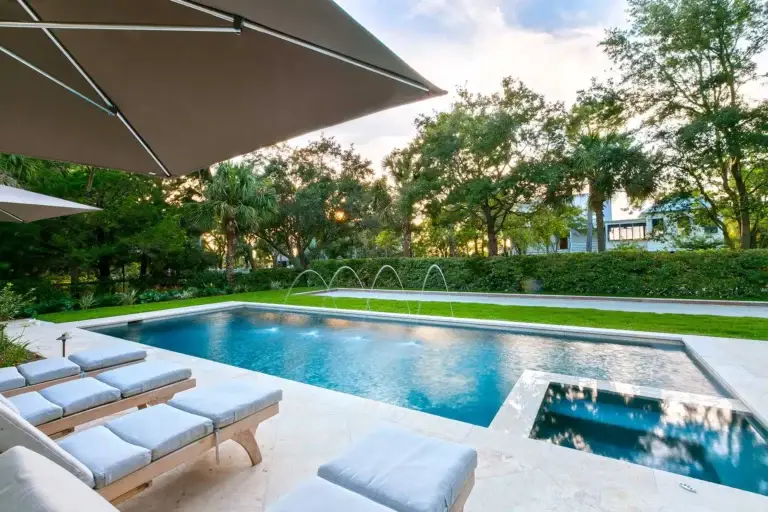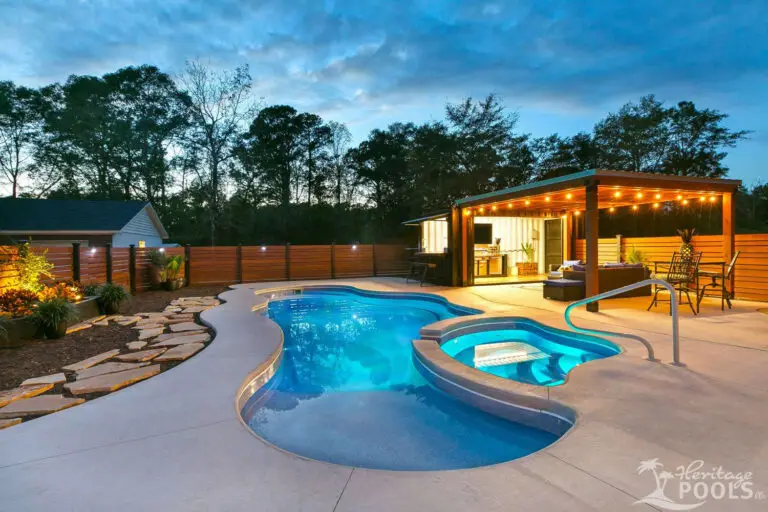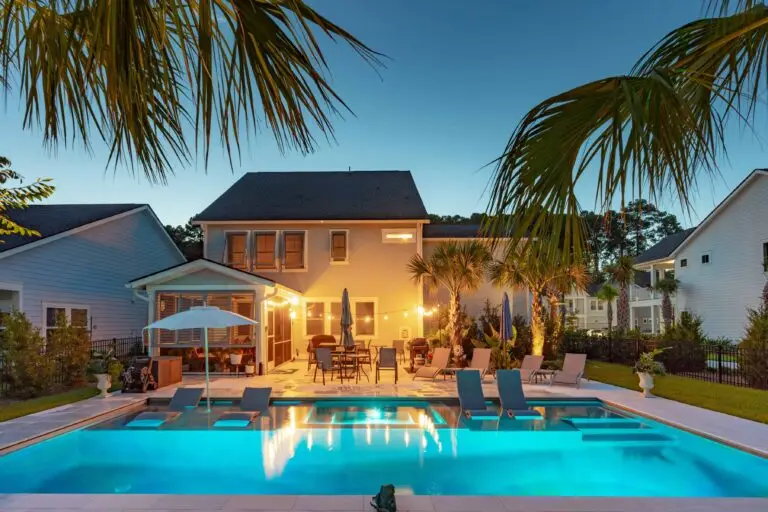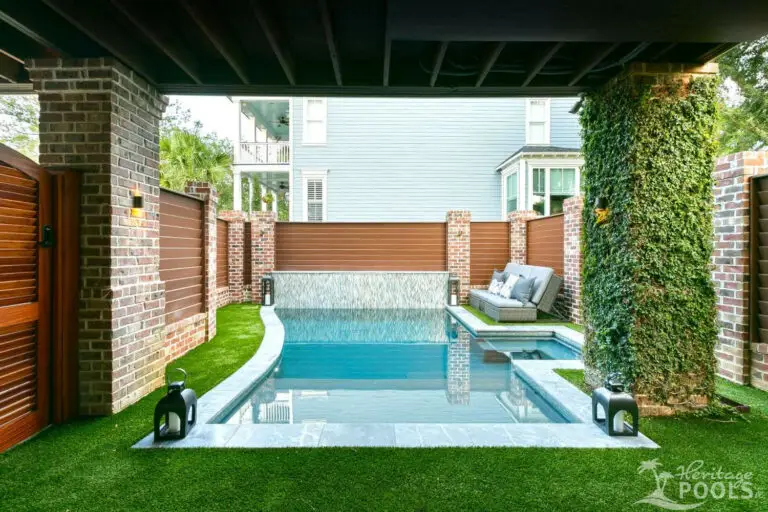Dealing with algae in your pool can be a frustrating and time-consuming process. It’s not only unsightly, but it can also make the water unsafe for swimming. Fortunately, there are steps to help show you how to get rid of algae in a pool.
In this blog post, we’ll provide an overview of the different types of swimming pool algae, explain how to get rid of it, and offer tips for preventing it from returning.
What is Pool Algae?
Pool algae can be a common problem for pool owners. It can come in different forms, and each type looks and behaves differently.
Green algae is the most common type of pool algae and it can be identified by its bright green hue. This type of algae typically forms in large clumps and can spread quickly, making it difficult to get rid of.
Black algae is another type of algae found in pools. It has a dark color and a rough, velvety texture. Black algae can also form in large colonies and is especially stubborn to remove.
Yellow algae is a less common type of algae that appears as yellow or gold-colored patches on the walls or floor of a pool. This type of algae is usually found in more shaded areas, as it needs less direct sunlight to thrive.
Overall, pool algae can be a nuisance and make swimming unpleasant. However, it’s important to remember that with proper maintenance, algae growth can be prevented or removed.
Can you Swim in a Pool with Algae?
It’s a common question, “Is it safe to swim in a pool with algae?” It is not. Algae in your pool can be dangerous, both to swimmers, your finishes, and swimming pool equipment.

Algae in my Pool: Why Does Pool Algae Form?
When it comes to why algae form in pools, there are a few main culprits. The first is the presence of nutrients, like phosphorus and nitrogen, which act as food for algae. If your pool has too many nutrients or they are not adequately balanced, algae will be attracted to the water. Another factor that encourages algae growth is direct sunlight and heat, which helps create an ideal environment for algae growth. Poor circulation can also contribute to algae growth, as stagnant water provides more time for algae to settle and spread.
Finally, if the pH levels in your pool are off balance, this can contribute to algae formation. Algae thrives in alkaline environments, so if your pH levels are too high then you may be dealing with more algae than normal.
By understanding why algae forms in pools, you can take the necessary steps to prevent and remove it quickly. If you notice any signs of algae, such as green, yellow or black spots, take action right away to get rid of it and keep your pool clean and safe.
The Different Types of Pool Algae
Pool algae is a common problem for pool owners and can come in three different colors – green, black, and yellow. Each type of algae has its own unique characteristics that affect how it grows and spreads in a pool.
Green algae is the most common form of algae found in pools. It thrives in warm, sunny environments and is easily spread by wind, rain, animals, and people. Green algae often appears as a slimy film on the surface of your pool and can also accumulate on steps, ladders, and other pool surfaces.
Black algae is a tough type of algae that is difficult to remove and is commonly found in poorly-maintained pools or those with stagnant water. The black algae spores can be spread through the water or even airborne. Once established, black algae develops a protective coating that prevents chlorine from penetrating it.
Yellow algae is not as common as green and black algae but still exists in some pools. Yellow algae requires sunlight and high levels of phosphorus to grow and can form thick mats on the walls of a pool. This type of algae is also resistant to chlorine, making it harder to eradicate.
How To Get Rid of Mustard Algae in a Pool
Pool algae forms due to a combination of warm temperatures, sunlight, and organic material such as leaves, dirt, or sweat. The combination of these factors creates an ideal environment for algae to grow and thrive in pools. In addition to regular cleaning and maintenance, proper chemical levels should be maintained to ensure proper water balance and limit the growth of algae.

How to Get Rid of Pool Algae
Getting rid of pool algae can seem like a daunting task, but it doesn’t have to be. To get rid of the pesky green, black, or yellow algae, there are a few simple steps you can take.
1. Shock the Pool: One of the most effective ways to get rid of algae is to shock your pool with chlorine. This will kill all types of algae, but the amount of chlorine you’ll need will depend on the size and type of algae present in the pool.
2. Brush Your Pool: Regularly brushing the sides and bottom of your pool will help prevent algae growth and keep your pool clean. Make sure to focus on areas that are particularly prone to algae such as around stairs, corners, and ladders.
3. Clean Pool Filters: Keeping your pool filters clean will help ensure that the water circulating through your pool remains free of debris, which can provide a place for algae to grow.
4. Balance pH Levels: A properly balanced pH level is crucial for keeping pool algae at bay. Make sure to test your pool water regularly and adjust pH levels as needed.
5. Clean the Skimmer Basket: The skimmer basket is designed to filter out dirt and debris, so it’s important to check and clean it regularly to prevent algae from forming.
By taking these simple pool care steps, you can successfully get rid of pool algae and keep it from coming back.
How to Prevent Algae from Forming
Preventing pool algae from forming is key to a clean and healthy swimming pool. Algae come in many forms, including green, black, and yellow algae, each with its own set of characteristics and growth patterns. By understanding the different types of algae, and implementing certain preventative measures, you can avoid the headache of dealing with an algal bloom in the future.
The first step in preventing pool algae is to keep your pool chemistry in check. Properly balanced pH and chlorine levels will help create an environment that is unfavorable for algae growth. Additionally, using an algaecide regularly can help reduce the chance of an outbreak. Algaecides are designed to kill existing algae and act as a preventive measure for further growth.
It is also important to make sure your pool filter and skimmer basket are regularly cleaned and maintained. A clogged filter or skimmer will not be able to remove particles that contribute to algal growth, leading to an increased chance of an algal bloom.
Finally, make sure to keep up with regular maintenance on your pool. Vacuuming the bottom of the pool weekly will help remove any potential food sources for algae, as well as any particles that could create favorable conditions for their growth.
By taking these preventative steps, you can reduce the chances of having to deal with pool algae in the future. With proper maintenance and chemical balance, you can rest assured that your pool will remain algae-free for years to come.

FAQs
What chlorine kills algae in pool?
High doses of pool-grade chlorine effectively kill algae.
What kills algae in a pool?
Chlorine, algaecides, brushing, and proper water balance.
Does shock kill algae?
Yes, pool shock eliminates algae by rapidly increasing chlorine levels.
What causes algae in a swimming pool?
Poor water circulation, imbalanced pH, nutrients, heat, and sunlight.
Get Rid of Algae in Your Pool With a Professional Help
Pro Note: Phosphates are the food for algae and if this level is not eliminated or lowered, no amount of shock and algaecide will remove the contaminants from the water.
If you’re dealing with green, black, or yellow algae and need professional help, contact Heritage Pools. Their experts have years of experience in the field and are able to provide expert advice and solutions to get rid of any type of algae in your pool.
Heritage Pools provides a comprehensive service to identify the type of algae present in your pool and provide an effective strategy for removal and prevention. They also provide regular maintenance services to keep your pool free from any type of algae, including green, black, and yellow algae. With regular pool maintenance, you can keep your pool looking clean and clear all year round.
The team at Heritage Pools understands the importance of safety when dealing with algae in a pool. They are committed to using the best products and techniques that are safe for both humans and animals. Their specialists will ensure that all necessary steps are taken to eliminate the presence of algae in your pool without causing any harm to your family or pets.
If you’re dealing with algae and need professional help, contact Heritage Pools today. Their experts can provide fast, effective solutions to rid your pool of any type of algae and keep it clean and clear all year round.




